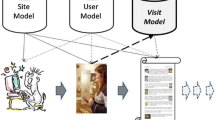Abstract
Information technology research has mainly focussed on supporting visitors with guides, whilst a lot of opportunities for the development of technology for collecting, manipulating and re-travelling through material from the visits remain unexplored. On the basis of observations from a specific setting, we have developed prototype technology to combine multimedia content with position information. In particular, we developed mobile support to record and organise multimedia using the walked path in order to preserve more of the experience of the visit. We created tools to edit and store multimedia paths. Additional components make it possible to configure a mixed-media environment to navigate a multimedia path, using such physical interfaces as gesturing, and link the recorded media to other artefacts. When discussing field observations of current practices and prototype trials, we investigate what kind of functionality is needed to support the whole activity of collecting, manipulating and playing multimedia content in combination with position information.












Similar content being viewed by others
References
EU IST project part of the Disappearing Computer Program, http://atelier.k3.mah.se/
Iacucci G, Wagner I (2003) Supporting collaboration ubiquitously: An augmented learning environment for architecture students, In: Proceedings of the 8th European conference of computer-supported cooperative work (ECSCW 2003), Helsinki, Finland, 14–18 September 2003
Büscher M, Kramp G, Krogh P (2003) In formation: Support for flexibility, mobility, collaboration, and coherence. Pers Ubiquit Comput 7:136–146
Davies N, Cheverst K, Mitchell K, Efrat K (2001) Using and determining location in a con-text-sensitive tour guide. IEEE Comput 34(8):35–41
Gaver B, Martin H (2000) Alternatives exploring information appliances through conceptual design proposals. ACM CHI 2000 2(1):209–216
Izadi S, Fraser M, Benford S, Flintham M, Greenhalgh C, Rodden T, Schnädelbach H (2002) Citywide: Supporting interactive digital experiences across physical space. Pers Ubiquit Comput 6(4):290–298
Pradhan S, Brignone C, Cui JH, McReynolds A, Smith TM (2001) Websigns: Hyperlinking physical locations to the web. IEEE Comput 34(8):42–48
Grinter RE, Aoki PM, Hurst A, Szymanski MH, Thornton JD, Woodruff A (2002) Revisiting the visit: Understanding how technology can shape the museum visit. In: Proceedings of the computer-supported cooperative work conference (CSCW 2002), New Orleans, 16–20 November 2002, pp 146–155
Randell C, Muller H (2000) The shopping jacket: Wearable computing for the consumer. In: Personal technologies, vol 4. Springer, Berlin Heidelberg New York, pp 241–244
Persson P, Espinoza F, Fagerberg P, Sandin A, Cöster R (2002) GeoNotes: A location-based information system for public spaces. In: Höök K, Benyon D, Munro A (eds) Designing information spaces: The social navigation approach. Springer, Berlin Heidelberg New York, pp 151–173
Tuulari E, Ylisaukko-oja A (2002) SoapBox: A platform for ubiquitous computing research and applications. In: Mattern F, Naghshineh M (eds) Lecture notes in computer Sc. 2414: Pervasive computing, Zürich, Springer, Berlin Heidelberg New York, 26–28 August 2002, pp 125–138
Kallio S, Kela J, Mäntyjärvi J (2003) Online gesture recognition system for mobile interaction. In: IEEE international conference on systems, man and cybernetics, vol 3, Washington, 5–8 October 2003, pp 2070–2076
Certeau M de (1988) Kunst des Handelns. Merve Verlag, Berlin
Acknowledgements
We are grateful to our co-researchers in the Atelier project, which is funded by the EU IST Disappearing Computer programme. We wish to acknowledge the contributions of Kari Kuutti, Anti Juustila and Virtu Halttunen (University of Oulu), Infotech Oulu for supporting this research at the University of Oulu, and Rüdiger Lainer, Andreas Rumpfhuber, Dieter Spath and the students of the Academy of Fine Arts in Vienna.
Author information
Authors and Affiliations
Corresponding author
Rights and permissions
About this article
Cite this article
Iacucci, G., Kela, J. & Pehkonen, P. Computational support to record and re-experience visits. Pers Ubiquit Comput 8, 100–109 (2004). https://doi.org/10.1007/s00779-004-0261-3
Received:
Accepted:
Published:
Issue Date:
DOI: https://doi.org/10.1007/s00779-004-0261-3




